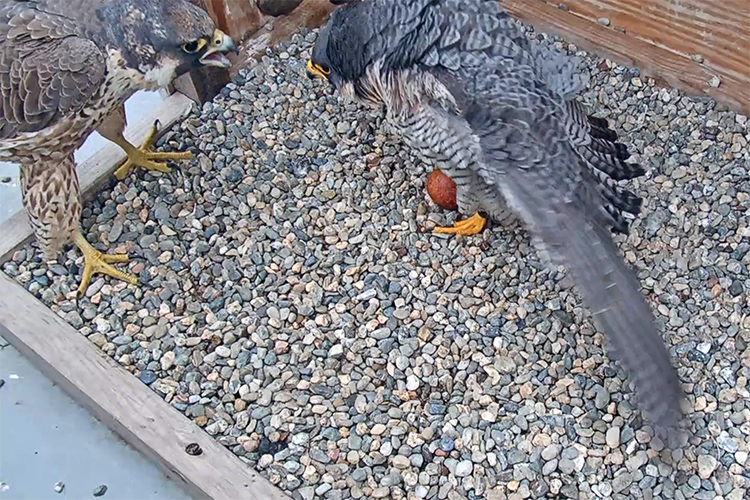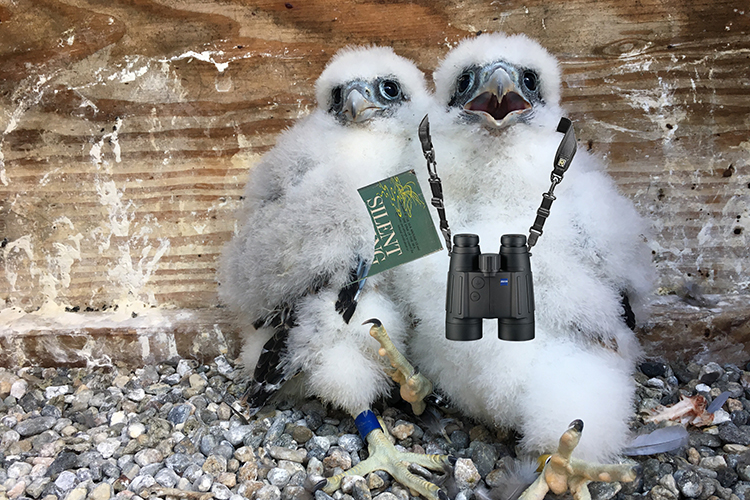Pip, pip, hooray! Here comes Hatch Day for Campanile falcons
Watch the hatch on Saturday, join a live YouTube Q&A with falcon experts at 3 p.m.
April 16, 2020

On their nest of gravel atop the Campanile, Annie (left) and Grinnell tend to their four eggs, which are expected to hatch sometime around Saturday, April 18. (Cal Falcons photo)
It could happen today, the first cracks, or pips, in the four peregrine falcon eggs high in a nest on UC Berkeley’s Campanile. Offspring of four-time falcon parents Annie and Grinnell, the chicks are expected to fully emerge this Saturday, April 18.
A campus Hatch Day event was held last year on the big outdoor screen at the Berkeley Art Museum and Film Archive, with passersby and reporters watching the babies’ appearance and asking questions of on- and off-campus falcon experts. This year, with COVID-19 social distancing rules in place, there are alternative opportunities to watch and learn.
To watch the hatching action, check the 24/7 Campanile webcam focused on the nest. Then, at 3 p.m. Saturday, tune in to a special live Hatch Day Q&A on YouTube hosted by Sean Peterson, a Ph.D. student in the Department of Environmental Science, Policy and Management, and biologist Lynn Schofield, the married couple that runs the Cal Falcons social media project. They and possibly a few more local raptor experts will answer questions while simultaneously showing what’s happening in the nest.
“Last year was such a fun celebration. It was really amazing to see the falcons on the big screen. It’s a bummer we won’t be able to throw a big bash this year, but it does give us an opportunity to try new things,” said Peterson. “We’re very excited that, by holding live Q&A sessions on YouTube, we’ll be able to share Hatch Day with people around the world, not just in Berkeley.”
The birds’ fan base, which now stretches across 45 countries, follows the birds on three webcams and hears the latest news on Instagram, Facebook and Twitter.

In late March, Grinnell (right) confronts a juvenile female falcon, which likely was looking for Bay Area real estate and had her eye on the Campanile falcons’ digs. Grinnell chased her off. (Cal Falcons photo)
Not only the four eggs, the last of which was laid on March 18, but a juvenile female falcon — either stopping to visit or looking to steal Annie and Grinnell’s territory — recently kept viewers glued to their seats and their screens. In late March, the interloper clashed up close with Grinnell, who was taking a turn incubating the eggs, and screeching and flapping ensued. At one point, she was in the nest with Grinnell and the eggs.
“She was up close and personal with Grinnell twice and flew by at least twice more,” said Peterson, who added that the visitor hasn’t been around now for about a week and a half.
“Annie and Grinnell are in prime condition, so they aren’t at a significant risk from a juvenile bird,” he said. “We’ve only seen the interloper interact with Grinnell, who is smaller (than the juvenile is). Annie will be much more aggressive, … and will probably convince the interloper to leave the Campanile entirely when they finally come face-to-face.”

The juvenile female falcon (left), who isn’t banded — otherwise, Cal Falcons could learn who she is and where she’s from — lands in the nest where father falcon Grinnell is incubating the four eggs that his mate Annie laid in March. (Cal Falcons photo)
Hatching behavior 101
When the chicks start hatching, their first activity is invisible to us, said Peterson. Between one and two days before they emerge from their shells, “an air cell in the egg expands, to allow the chicks to begin breathing using their lungs. At this point, the chicks have also absorbed the entire yolk.”
The very first small pips in the eggshells allow fresh air to come into the eggs and for communication to begin between the chicks and their parents, he said.
“Annie and Grinnell will be making very quiet vocalizations to encourage the chicks to break out of their eggs during this process, and the chicks will be very quietly vocalizing back,” said Peterson. “We’re expecting the first pip to show up sometime around Thursday. It would appear like a small crack in the eggshell, barely perceptible. Hopefully, we’ll get some good zoomed-in pictures of the eggs to see if we can see (the pips).”
Peterson said there is no evidence of external damage to the eggs, “so it’s fairly likely all four will hatch. However, you can never be certain: Last year, one of the (three) eggs began to hatch, but didn’t quite make it. We’ve got our fingers crossed that all four will succeed this year.”

Cal Falcons photo-edited this image of Carson and Cade, the chicks born to Annie and Grinnell last year, for this May 27, 2019 social media post. That day, the birds were formally named in a Cal Falcons contest. Carson, left, was named after conservationist Rachel Carson, who wrote The Silent Spring, about the effects of pesticides on the environment. Cade was named after Tom Cade, who led the effort to reintroduce peregrine falcons after DDT had nearly eliminated them. (Cal Falcons image)
Cal Falcons will hold a naming event for the hatchlings, likely the second week of May. Names will be solicited from the public via social media, and a vote will be held on a selection of finalists.
The winning names of last year’s chicks were Carson and Cade. Carson was named for biologist Rachel Carson, author of The Silent Spring, which told how bird populations suffered from the widespread application of DDT. The synthetic pesticide drove our nation’s peregrine falcons and other bird populations to the brink of extinction. Thanks to environmentalists and a DDT ban by the U.S. government in 1972, the falcons are no longer endangered. Cade got his name from Cornell University ornithologist Tom Cade, who founded the Peregrine Fund in 1970 to help bring the DDT-hit species back.
Peterson and Schofield, who have been educating Cal Falcons followers almost daily via social media with photos, video and interesting facts about Berkeley’s falcons and other local raptors, answer questions regularly from those who read their posts.

From left, chicks Berkelium, Californium and Lawrencium, named after three elements discovered at Berkeley, were born in 2018. (UC Berkeley photo by Maria Garcia-Alvarez)
Lately, a popular question has been whether Annie and Grinnell will be able to handle four chicks. “Carson and Cade must have looked like a handful, or wingful, last year!” said Peterson.
In 2017, Annie and Grinnell welcomed two chicks — Fiat and Lux. Lux died when she hit a window while learning to fly. In 2018, there were three new chicks — Berkelium, Californium and Lawrencium, or Larry. Larry, a female, has set up territory on Alcatraz Island, indicating she’ll be a mother soon.